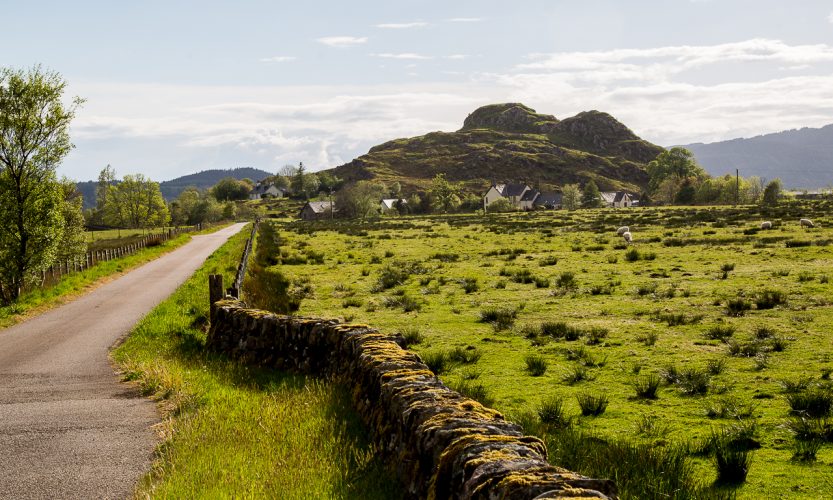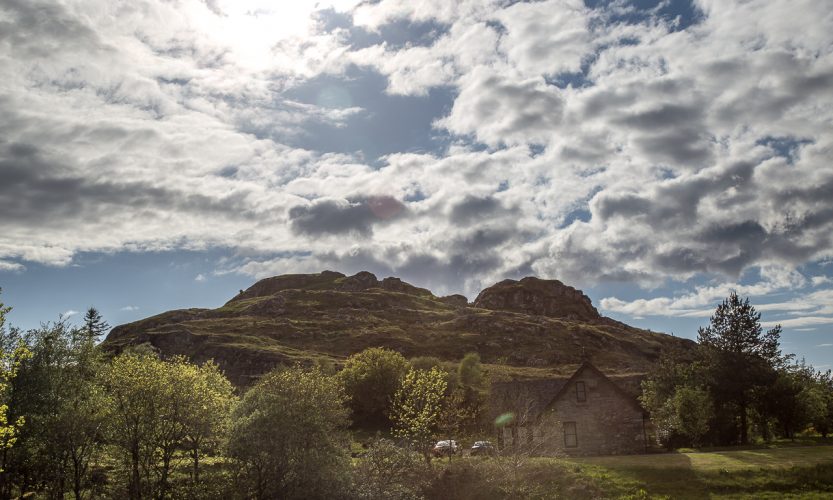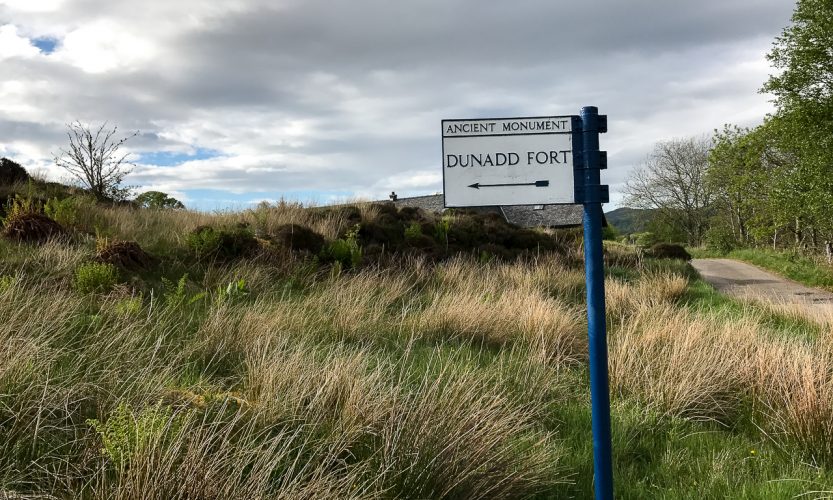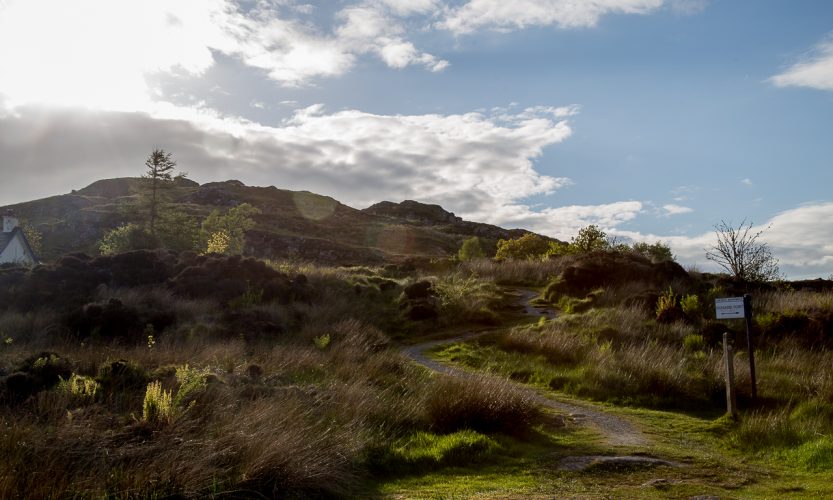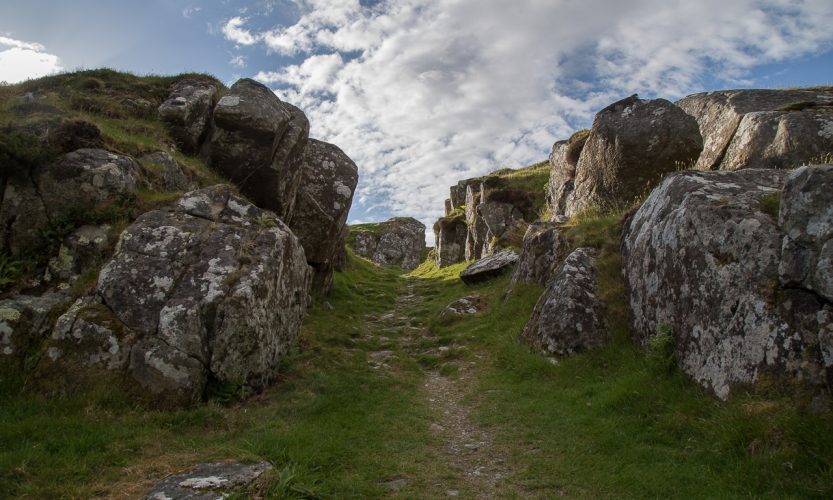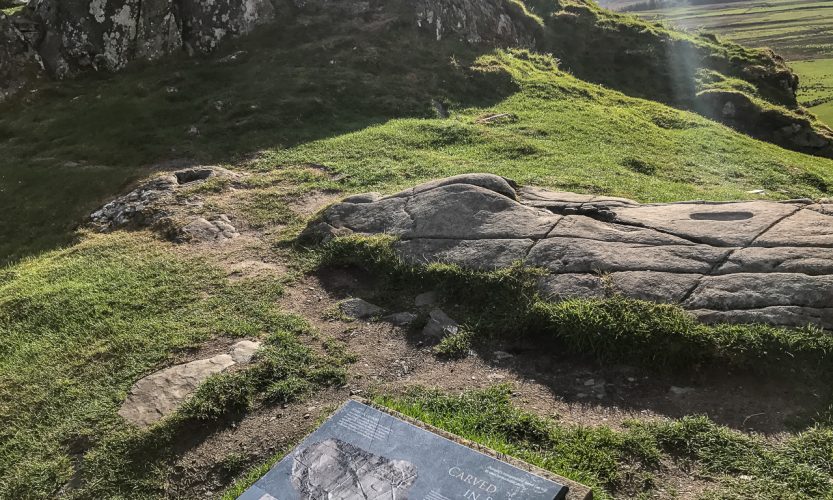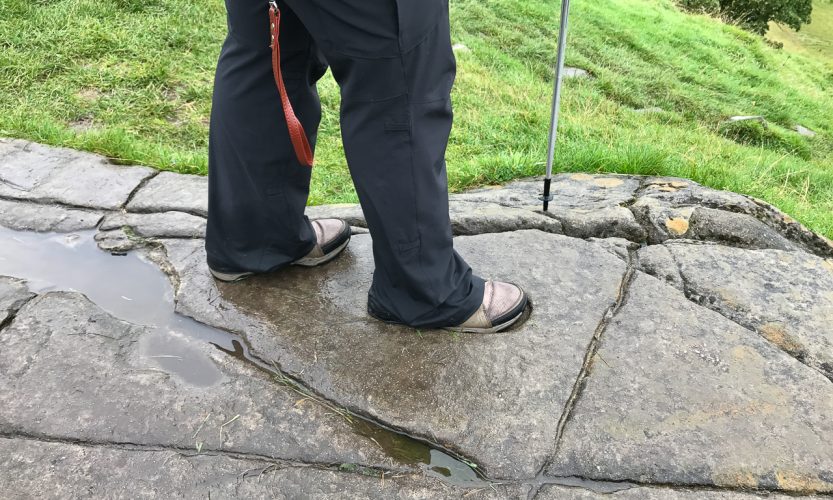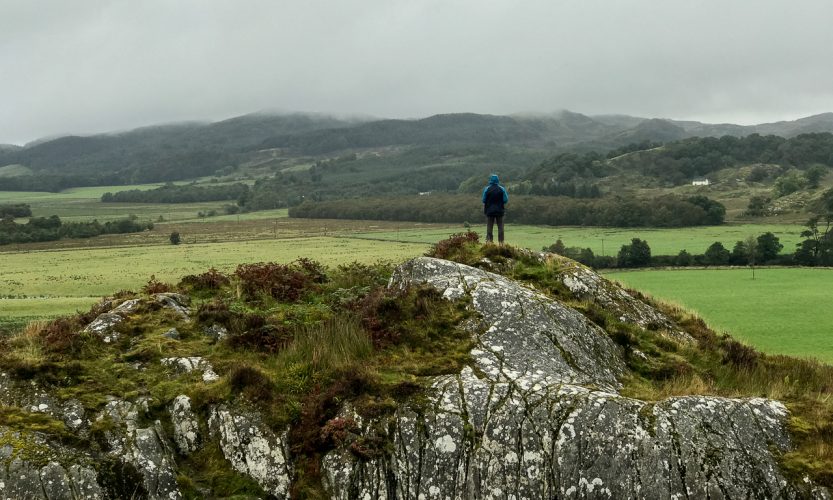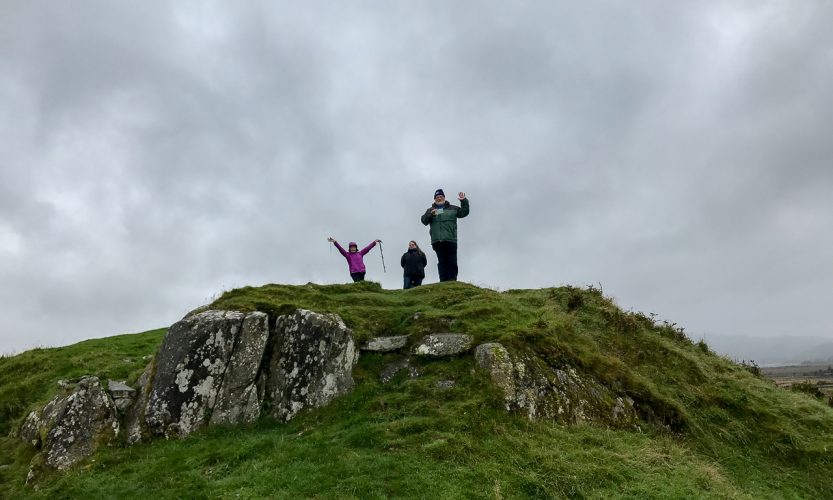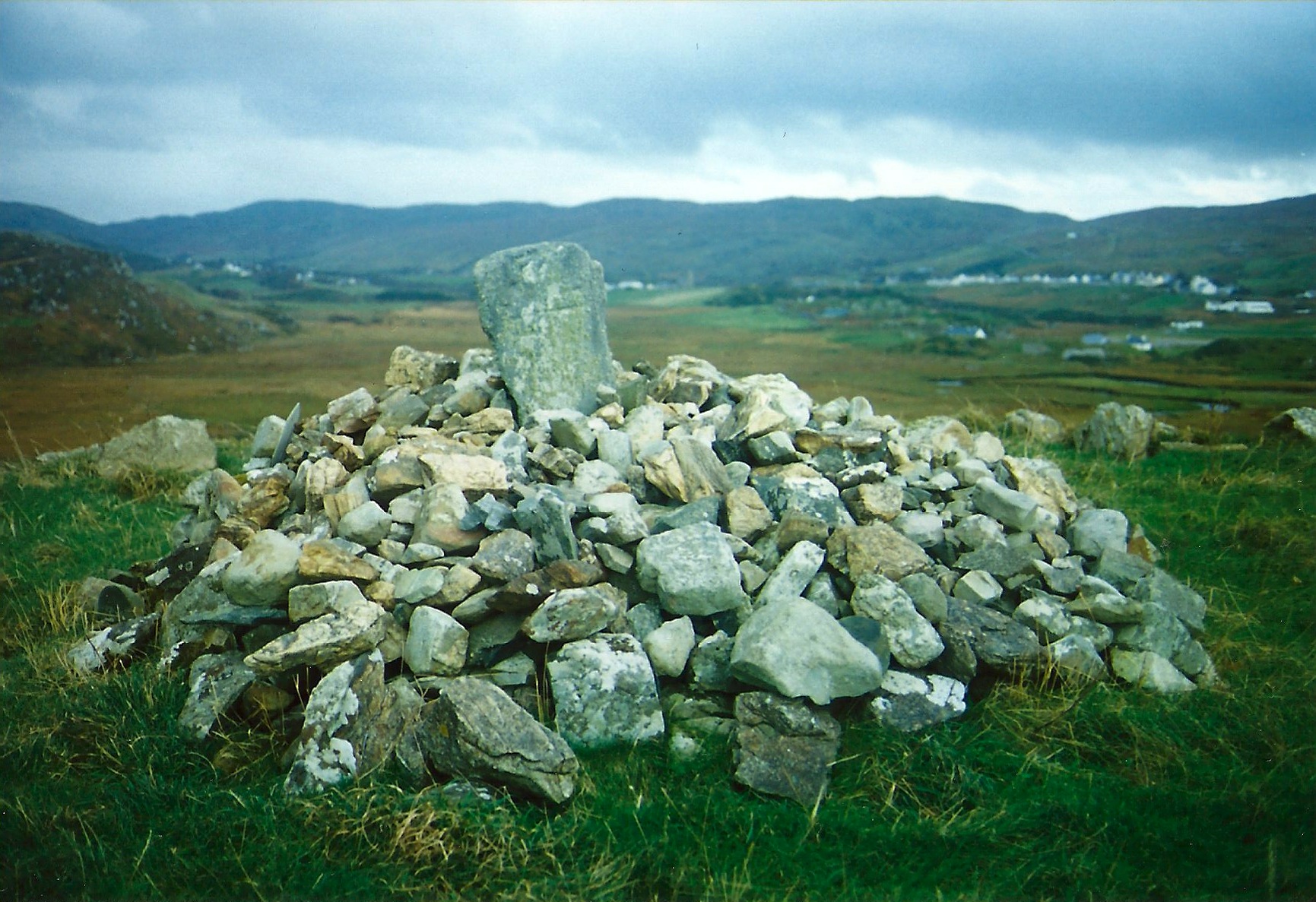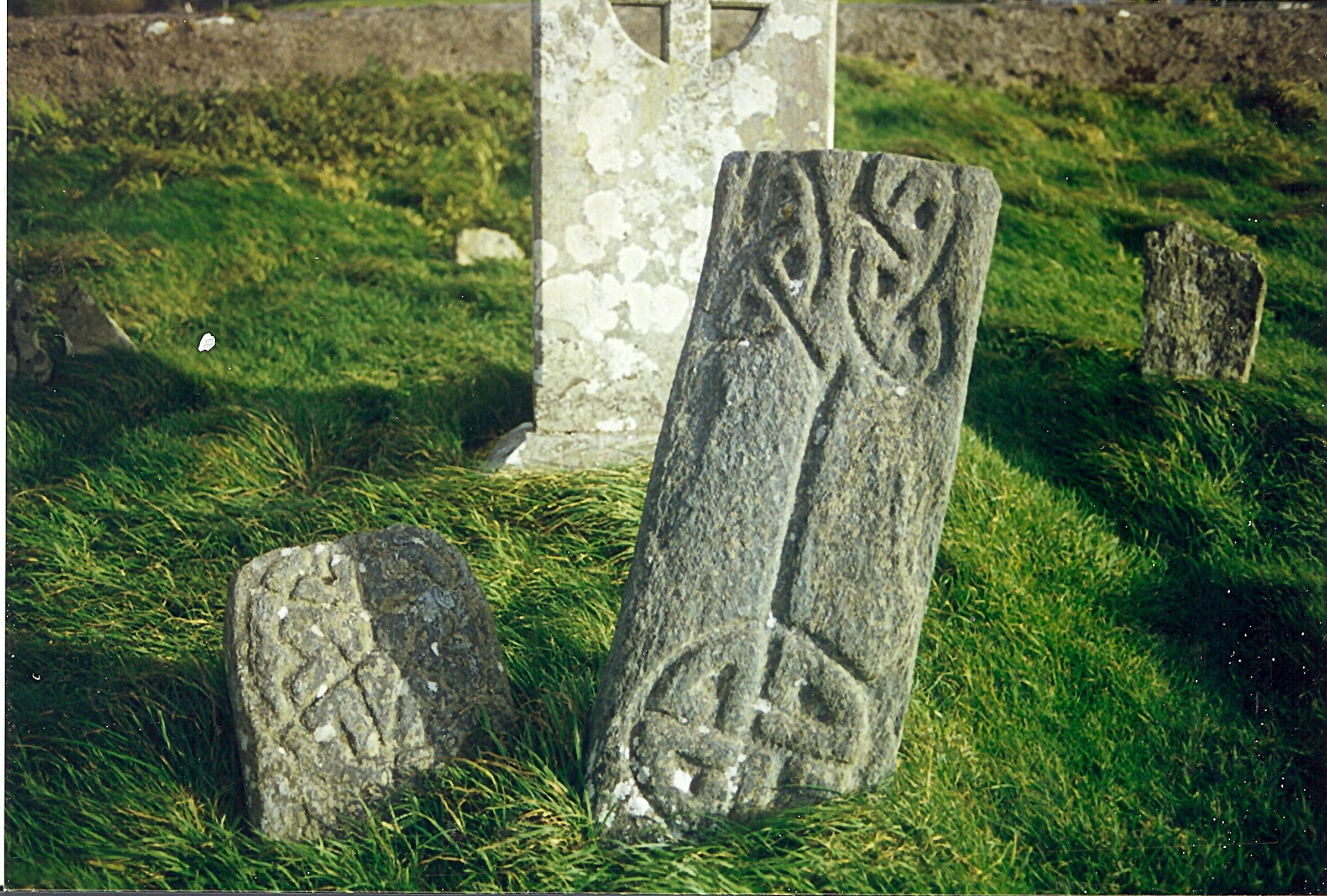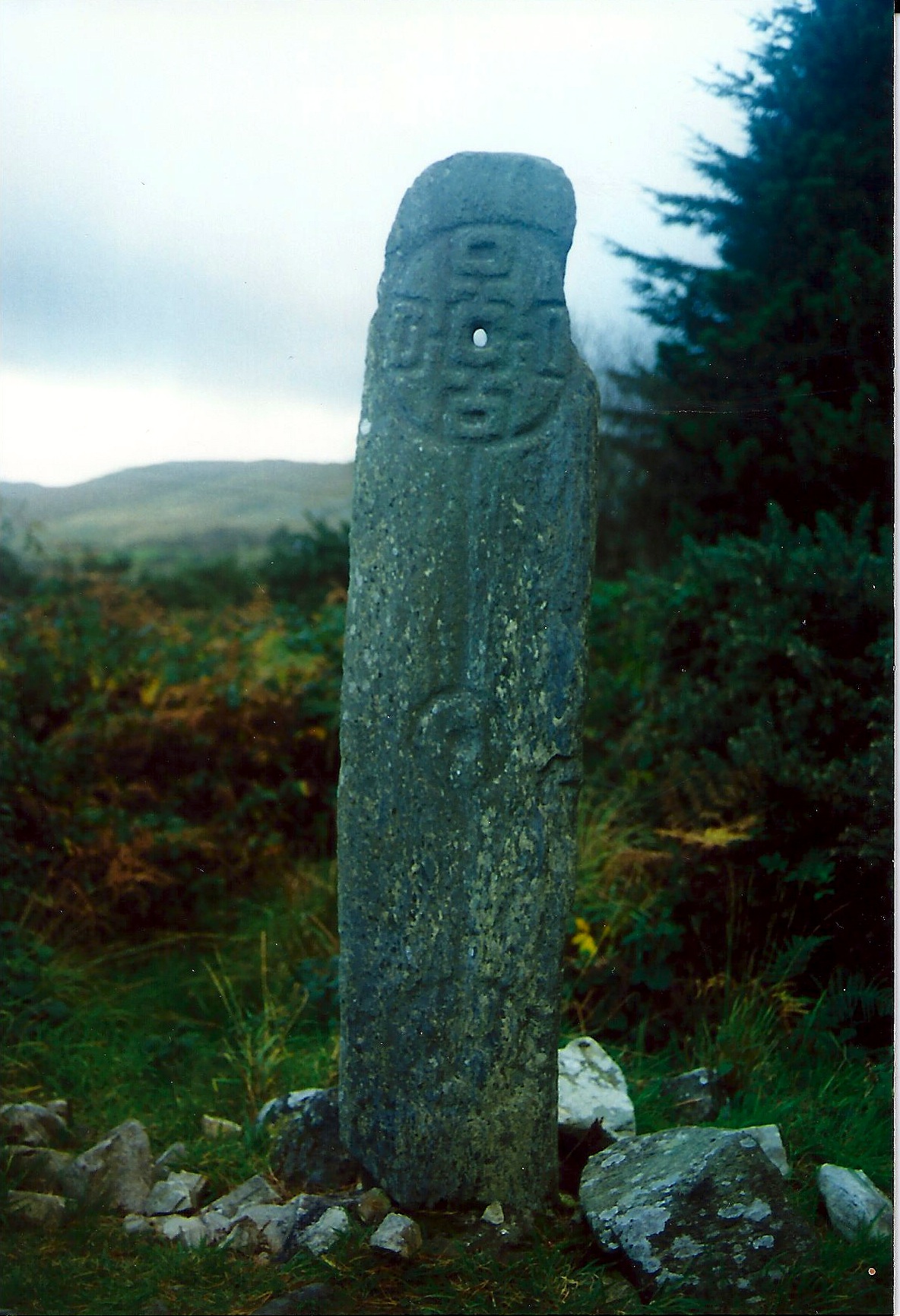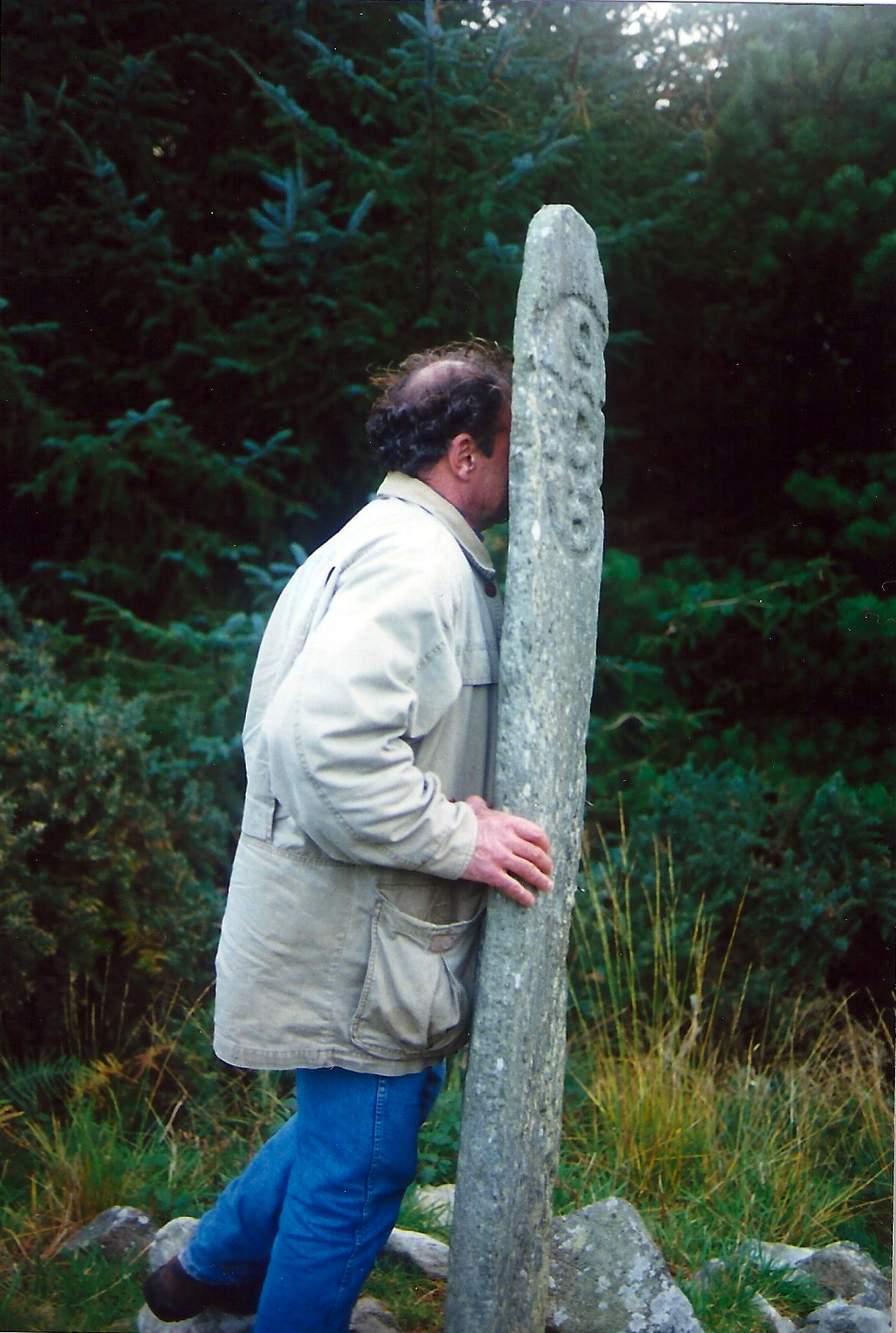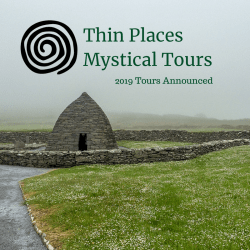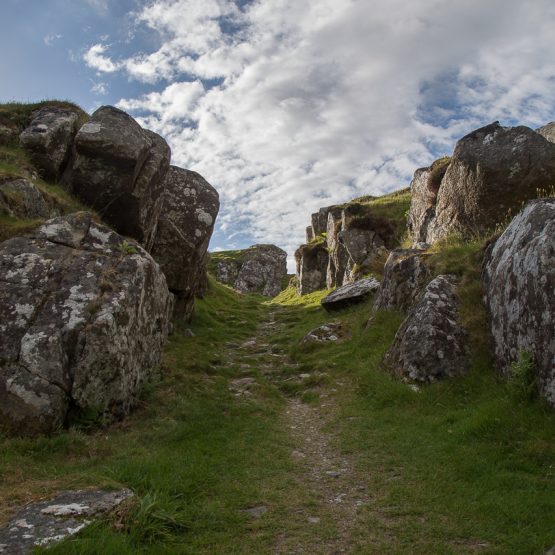Dunadd Fort – Kilmartin Glen
Dunadd – Ancient Royal Center – Kilmartin Glen
The remains of Dunadd Fort in the Kilmartin Glen in Argyle, Scotland rise out of the Glen like an old boulder dropped from the heavens. Everything around it is flat – and then, there it is. A lumpy hill that is perhaps 4 stories high sitting in a landscape that houses over 300 ancient monuments – the largest collection in all of Scotland. This was the 6th century political and ritual site where the first Scottish Kings were crowned, and where they ruled from. Here is a one minute video showing the path from the valley floor to the Citadel.
This site not only has an ethereal feel at the top, it vibrates with ancient, almost celestial energy. The spiritual energy is almost overwhelming when one climbs to the top alone. The entire ascent to the top becomes a walking meditation.
The Kilmartin Glen
The Kilmartin Glen has over 300 ancient monuments in a few square miles. Dunadd is one of them and situated at the end (or beginning) of a linear trail that holds most of the megalithic structures.
When I set out to explore the ancient monuments, I was looking for the stone circles, the standing stones, the tombs, the rock carvings. As I up the A816 from Lochgilphead I knew that I was coming into the Glen and was watching for directional signs to the monuments. I happened to look left and saw this lone, rocky hill and thought how strange it was to be situated there in all of that flatness. Then I saw the signage for Dunadd Fort and realized that this rock in the middle of the Glen was, in fact, one of the monuments.
Ancient Seat of the Early Scottish Kings
Though fortifications of this fort go back 2400 years, the hill’s use as a royal site and political center run from about 600 to 750 AD. This was the royal seat of the Dál Riata tribe. They had a common language and culture with the Ulster tribes in the north of Ireland. The descendants of this tribe were the Scotti (the name Scotland derives from this group).
Though it looks like a lumpy rock, it was once fortified with a protective rampart there were also dwellings, a well that served the entire community on the rock and even an industrial center where jewelry was made for royalty and the social elite. Up at the top of the rock was the site where royal rituals took place.
The Inauguration Stone
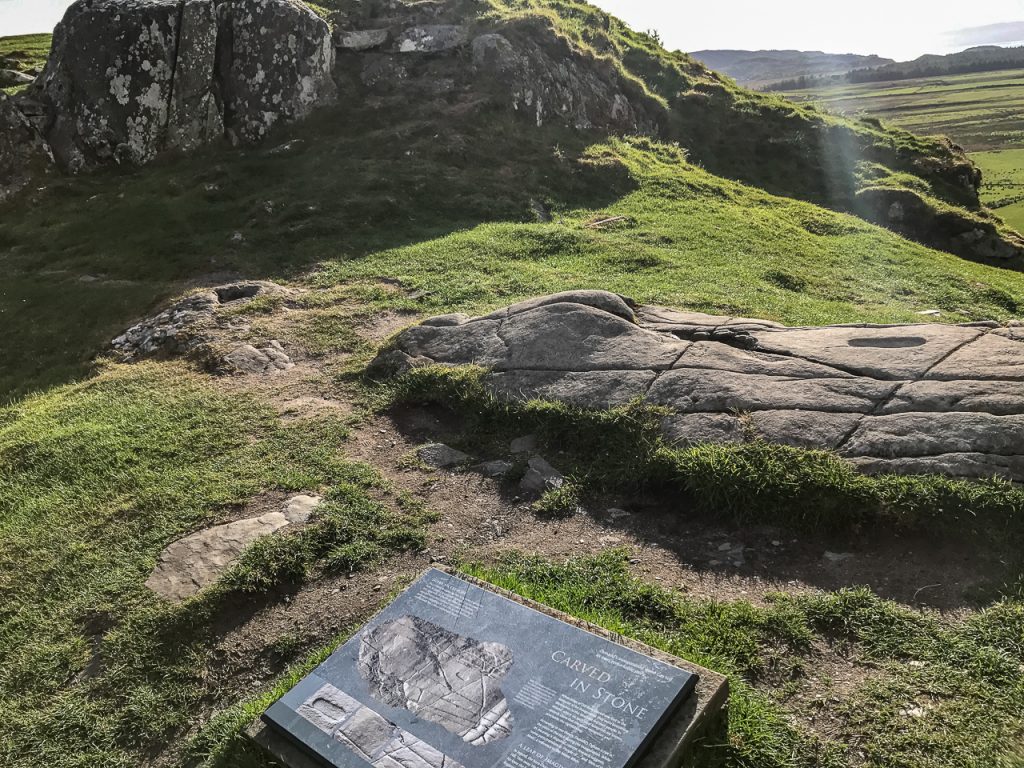
The most impressive artifact remaining on the site is the Inauguration Stone. At the top of the hill (at the lower elevation) is a flat stone with a footprint carved out. There is also ogham writing on the stone and other writings believed to refer to sacred rituals. The candidate for king would be brought here in a procession and a ritual would be carried out on this spot where the pending king would place his foot in the footprint on the sacred stone signifying that he was married to the land – and hopefully this marriage between king and land would yield fruitful harvests and a blessing on the people.
The actual stone used in the 7th and 8th century lies beneath the one we see currently at the crest of Dunadd. A concrete replica was placed overtop the original in order to protect the original stone. But it gives the visitor a glimpse of what the actual stone looked like in this place.
I snapped a photo (pictured above) of the stone and noticed later that a beam of sunlight was shining directly on the footprint. It was a magical time up there all by myself.
The Citadel at Dunadd.
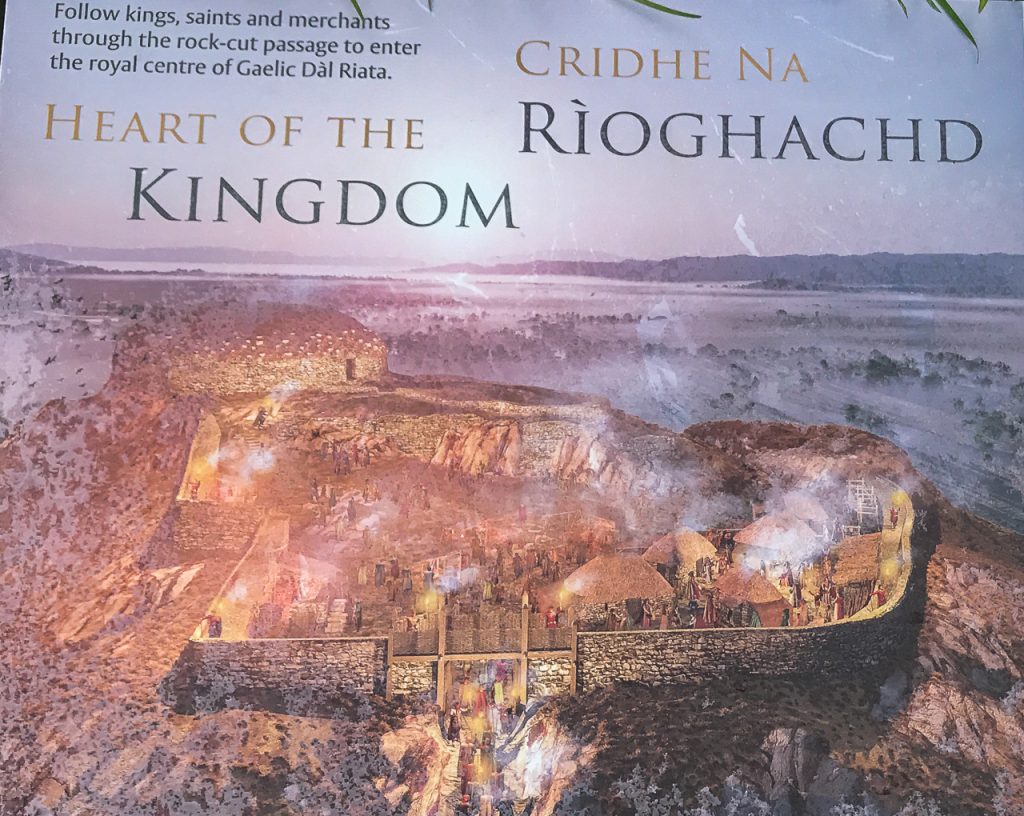
Image of what the Citadel may have looked like.
Directly above the Inauguration Stone at the highest point on the hill, is a slight rise to a flat terrace level. Researchers believe this was a citadel – an enclosed building where political discussions were held. It was the governmental meeting place situated perfectly at the top of the hill.
The panoramic views from this plateau are stunning and take in all of the Kilmartin Glen which sits on the banks of the snaking River Add. The island of Jura can be seen in the distance. Iona is only 35 miles away.
St. Columba and Iona
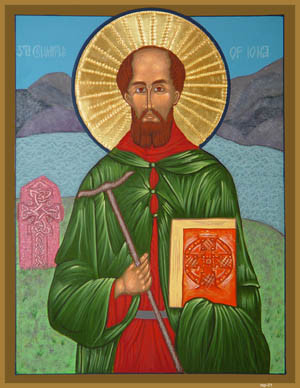 The Irish have a wonderful tale about the self-imposed exile of St. Columba. After his prideful actions caused a war between Irish tribes that cost lives and treasure and brought sorrow to the people, Columba got in a boat with twelve followers and set out from Derry heading for a new home. He stopped at the first island he came to where he could no longer see his beloved Ireland and that was Iona where he founded (started) Christianity in Scotland.
The Irish have a wonderful tale about the self-imposed exile of St. Columba. After his prideful actions caused a war between Irish tribes that cost lives and treasure and brought sorrow to the people, Columba got in a boat with twelve followers and set out from Derry heading for a new home. He stopped at the first island he came to where he could no longer see his beloved Ireland and that was Iona where he founded (started) Christianity in Scotland.
Scottish historians believe that Columba negotiated with King Comgall in about 563AD to use Iona for the founding of a monastic community. That negotiation would have most likely occurred in this Citadelidel on the top of Dunadd Fort. Remember these Argyle tribes were related to the northern Irish. They spoke the same language and shared an ancestral history. It’s likely that the King would benefit by having Columba found a monastery because monastic communities brought education to the people and Columba had a successful track record a mile long.
So while the story of the meeting between Columba and King Comgall isn’t as romantic as the Irish story of sailing into the west and arbitrarily landing on Iona, it’s quite a rush to stand on the Citadel at Dunadd Fort and imagine that you’re standing in the same spot where Iona and Christianity were likely negotiated by King and Monk.
Powerful Energy Still Lingers
Setting all the history and stories aside, Dunadd Fort has an energy that is nearly palpable at the top. Climbing it requires great care both ascending and descending, but it can be done carefully. Great care should be taken if the stones are wet because they are slippery. The views and the atmosphere for meditation are worth the effort.
St. Columba and Glencolumbkille
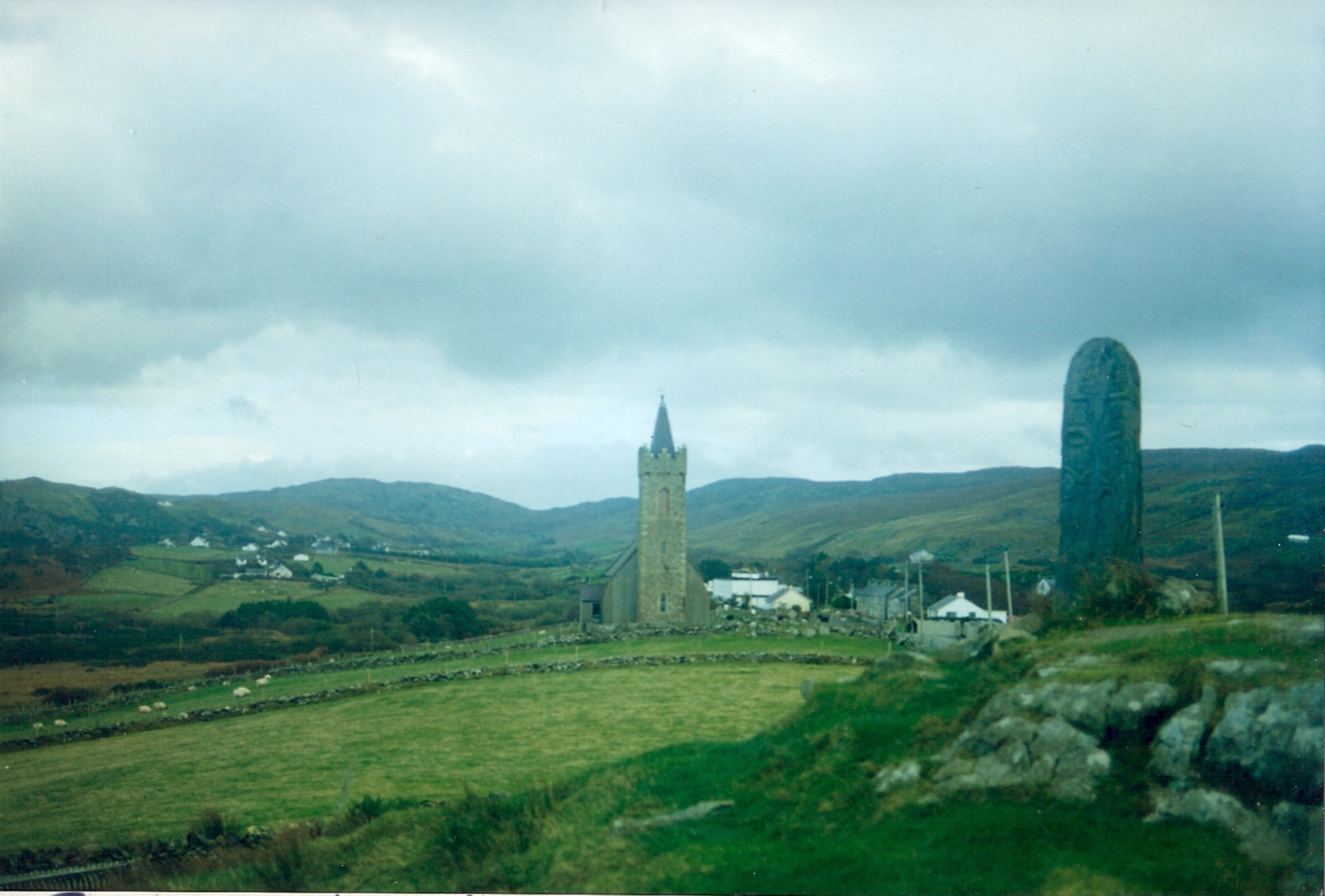 Glencolumkille is a rural parish in southwest County Donegal. It is most known for its pilgrimage that honors the patron saint and protector of Donegal, St. Columba. There are many variations of his name (Columbkille, Colmcille). The Pilgrimage of St. Colmcille, also known as the Turas Cholmcille honor the saint while personally drawing his blessing and strength by walking in his footsteps across a land that was once his home. There are 15 stations scattered throughout an enchanted glen – each marked by a pillar stone or cairn or some type of stone marking.
Glencolumkille is a rural parish in southwest County Donegal. It is most known for its pilgrimage that honors the patron saint and protector of Donegal, St. Columba. There are many variations of his name (Columbkille, Colmcille). The Pilgrimage of St. Colmcille, also known as the Turas Cholmcille honor the saint while personally drawing his blessing and strength by walking in his footsteps across a land that was once his home. There are 15 stations scattered throughout an enchanted glen – each marked by a pillar stone or cairn or some type of stone marking.
My favorite definition for “pilgrim” was written by Paul Elie, found in his book The Life You Save May Be Your Own, a book about great writers and the power they have over us. Paul says, “A pilgrim travels within the context of a story, in order to be changed by the story.” The definition certainly fits the pilgrims who do the Turas in Glencolumkille.
To remember the story of St. Columbkille is to remember a man who was a descendent of the ruling tribe – royalty in his day. A man who was educated and tutored by the best scholars. Columbkille was a leader who could shape meaning from circumstances. He founded more monasteries and monastic communities than any other single Irish saint. But pride got the best of him when he was at his most powerful, and he picked an fight with another saint – St. Finian who had an illustrated psalter. St. Columbkille secretly copied St. Finian’s book so that he would have a copy for himself.
St. Finian was offended and demanded Columbkille’s copy. Columbkille refused saying knowledge gained from books should be shared not coveted, especially when pertaining to God. Finian took the matter to the High King for arbitration and the High King ruled in favor of St. Finian with a famous statement – “To every cow its calf and to every book it’s copy” meaning every calf belongs to its mother and every copy of a book belongs to the original book’s owner. Columbkille was outraged in losing the battle and this disagreement eventually led to Columbkille’s tribe attacking a tribe to the south which led to the slaughter of over 3000 people.
Columbkille was so ashamed to have been the root of so much death and destruction in his native land, that he sent himself into voluntary exile. He sailed from his beloved Derry to Scotland landing with a few followers on the island of Iona where he established a community which flourished into a great seat of learning and spiritual growth. Iona still has a community there and it continues today to draw pilgrims.
So as the pilgrims travel through the station in Glencolumbkille, they reflect on the saint’s life, his strength, his weaknesses and his devotion, and they ask his blessing for own lives. Every station has a ritual, a prayer to be said, a devotion to be made. So that when the turas are all done, the pilgrim has drawn strength from both the story and energy of the land.
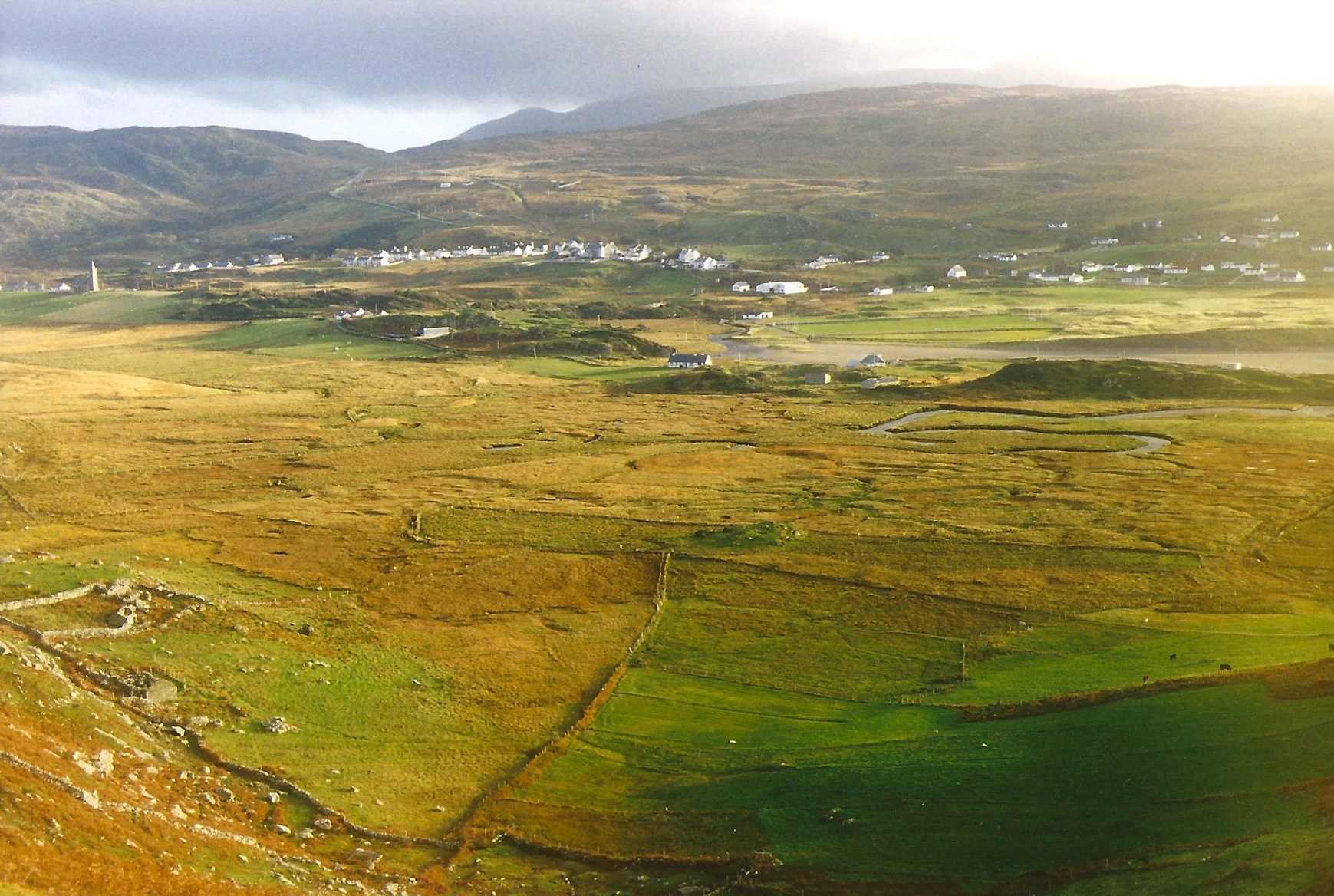 The land has been considered sacred for thousands of years. Devotion and ritual in the glen dates back thousands of years. Portal tombs dating from 2000 BC can be found in the glen as well as court tombs the date to 4000 BC. The land in Glencolumbkille has an energy that early civilizations felt … that has lasted until the present day.
The land has been considered sacred for thousands of years. Devotion and ritual in the glen dates back thousands of years. Portal tombs dating from 2000 BC can be found in the glen as well as court tombs the date to 4000 BC. The land in Glencolumbkille has an energy that early civilizations felt … that has lasted until the present day.
Though Ireland has suffered in recent years with abuses committed by Catholic clergy which has rocked the faith of many, there are still hundreds that come to the glen each year to do the rounds. This kind of joining of devotion, spirit, land and healing never betrays trust.
I visited Glencolumbkille shortly after I married my husband. Our favorite spot was the Stone of Gathering (Turas 9). This tall carved pillar has a hole in the top. The stone was tied to a tradition where engaged couples would intertwine their fingers in the hole while professing their love and commitment to each other before a gathering of community members. There is also a tradition that if you peer through the hole (as Dan is doing in the image above) you will get a glimpse of heaven. The view from where Dan is standing is breathtaking. There is a special energy around this pillar… a kind of loving, warm, peaceful energy.
At the southwestern tip of Glencolumbkille is Slieve League (Sliabh Liag) which is the highest cliff face in Western Europe. The monastic serenity that blankets the entire glen and its scenic surroundings moves from peaceful to powerful – back and forth – and the prayers of the pilgrim mirror that energy.
“…echoes of the centuries’ feet
That moved along the penitential stones
In all thy winds are sweet.
Here came my fathers in their life’s high day
In barefoot sorrow, but God knows the whole:
Not for themselves they fasted, but to lay
Up riches for my soul.”
Glencolumkille and Slieve League are stops on the 2013 Thin Places Mystical Tour of Ireland. Check out the itinerary.
Other Good Webpages on Glencolumbkille and the Turas
Voices from the Dawn – Glencolumbkille Turas
Megalithic Ireland – Glencolumbkille Turas
